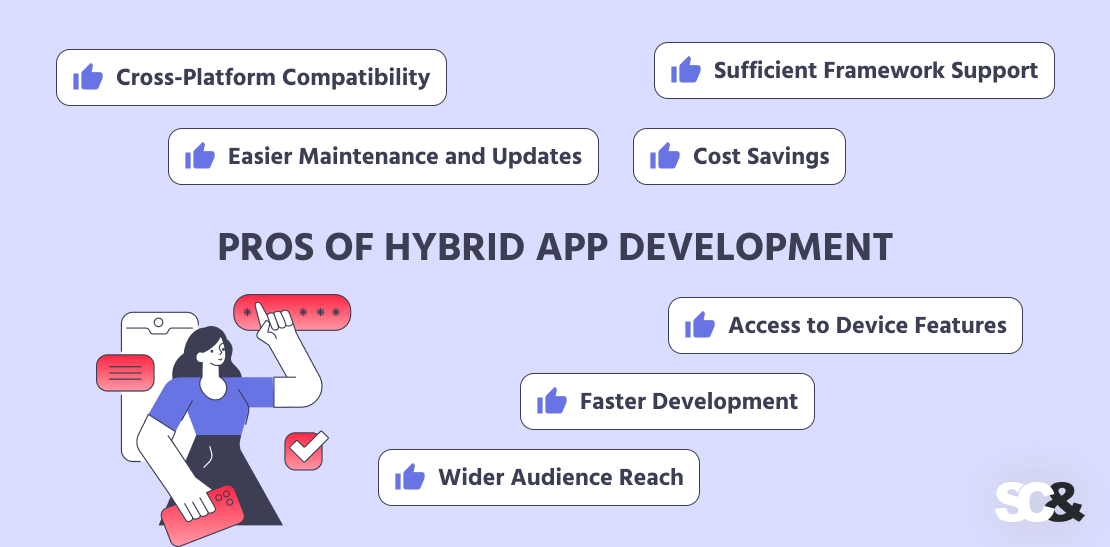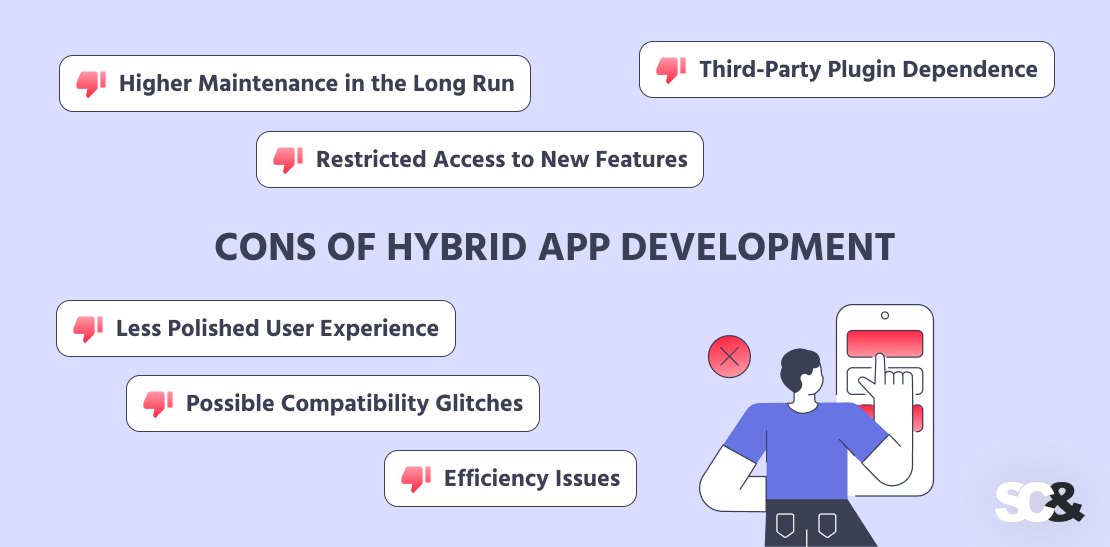Hybrid App Development: Pros and Cons
When businesses plan to launch a mobile application, one of the first decisions they face is how to approach the mobile app development process. Should they opt for a native app for the highest performance or a hybrid app for the sake of time and cost savings?
The drawback of the native approach, according to Forbes, is that it takes longer to create, is very costly, and it’s difficult to make both apps look and behave in precisely the same manner.
Hybrid app development has become a popular middle ground, especially for startups and companies looking to reach wider audiences.
What Is Hybrid App Development?
Hybrid mobile applications are a type of apps created with web technologies (HTML, CSS, and JavaScript) and then wrapped inside a native container so they can run on multiple platforms.
Through this approach, developers can create the application once and then distribute it across various devices, thereby saving time and reducing development costs.
Unlike native apps, which are each developed independently for each platform using Swift (iOS) or Kotlin (Android), hybrid apps incorporate both web and native elements and utilize the flexibility of web development without compromising access to core device capabilities.
Compared to web apps, which are run exclusively within browsers, hybrid apps can communicate directly with a device’s operating system and hardware.
They can use the camera for photos or AR capabilities, GPS for geolocation services, push notifications to send reminders, and offline storage for activities requiring large amounts of data.
There are two main approaches to building the container:
- Native container — a custom native application that embeds a WebView (using platform SDKs, e.g., WKWebView on iOS or WebView on Android) and optionally implements a JavaScript–native bridge for accessing device APIs, without relying on third-party hybrid frameworks.
- Framework-based container — using solutions like Apache Cordova (PhoneGap) or Ionic, which provide a ready-made container and plugins for accessing device capabilities, simplifying development.
| Feature | Native Apps | Web Apps | Cross-Platform Apps | Hybrid Apps |
| Development | Platform-specific | Browser-based | Single codebase via frameworks | Web tech + native wrapper |
| Performance | High | Low | Near-native | Medium |
| UX/UI | Excellent | Limited | Near-native | Moderate |
| Cost | High | Low | Medium | Low/Medium |
| Development Time | Slow | Fast | Medium | Fast |
| Device Access | Full | Limited | High | Moderate |
| Best For | Games, AR, fintech | Simple apps | Cross-platform apps | MVPs, business apps |
Native vs Web vs Cross-Platform vs Hybrid Apps: A Detailed Comparison Table
Pros of Hybrid App Development
Hybrid apps offer businesses a fair compromise of speed, affordability, and capabilities. They won’t always be on par with native apps in terms of performance, but they have a lot of advantages that make sense in certain cases.

1. Cross-Platform Compatibility
Hybrid apps support both iOS and Android through a unified codebase. Put simply, companies do not need two teams of developers and can enter the market more rapidly.
2. Cost Savings
Since most of the code is shared between platforms, hybrid apps are often less expensive to develop and maintain compared to native apps. This comes in handy for small businesses or startups that must hit the ground running without huge capital investment.
3. Faster Development
With hybrid frameworks, developers can reuse code and deploy updates to all platforms. This way, they decrease the cycle of development and can deploy MVPs (minimum viable products) way faster.
4. Access to Device Features
Hybrid apps can take advantage of device functionality through plugins and APIs. They may access the camera, GPS, push notifications, and other native features to sustain user engagement.
For instance, the beer enthusiast app Untappd uses hybrid technology for incorporating check-ins, notifications, and location-based functionality across platforms.
5. Easier Maintenance and Updates
Since hybrid apps share a common codebase, it is simpler to mend defects, enhance functionality, or renovate designs. All users receive updates at the same time, and maintenance is significantly easier.
Cons of Hybrid App Development
Despite the advantages of hybrid apps, they do have some drawbacks that mainly concern performance.

1. Efficiency Issues
Hybrid apps are normally slower than native apps because they use a web layer inside a native shell. Such a composition would be problematic for heavy graphics, animations, and live capabilities inherent, for example, to games or AR/VR applications.
2. Less Polished User Experience
Native app development follows platform-specific design principles, and therefore, native apps feel more intuitive for users. Hybrid apps sometimes cannot equal this with ease, especially when the app has sophisticated designs or animations.
3. Third-Party Plugin Dependence
Not all hybrid approaches require plugins to access device functionality — if a native container is written directly (e.g., with Swift or Kotlin), developers can use platform APIs without extra dependencies.
However, when frameworks like Ionic or Apache Cordova (PhoneGap) are used, hybrid apps often rely on third-party plugins to interact with device features. If a plugin is outdated or contains bugs, it may cause delays or limitations.
4. Restricted Access to New Features
When new operating system features are released, native apps usually get them first. Hybrid platforms may somewhat lag behind, which can be a disadvantage if an application necessitates the latest capabilities, such as advanced camera APIs or AR features.
5. Higher Maintenance in the Long Run
Hybrid solutions are originally cheap, but costs may rise as the app grows. Developers may need more time and effort to correct performance issues or update plugins.
For example, a lightweight MVP will be cheap to create as a hybrid app, but when it grows to be a large product, more effort may be needed to make it perform optimally.
6. Possible Compatibility Glitches
Since hybrid apps have to run on a wide range of devices and operating systems, small bugs or design errors can show up more often than with native apps.
When to Choose Hybrid App Development
Hybrid app development is definitely a good choice if you want to have an app off the ground quickly, yet without spending much money making several separate OS versions.
Probably, the most obvious target audience for hybrid development will be small businesses or startups that want to test an idea or launch a minimum viable product.
For example, a new food delivery company could use a hybrid app to swiftly gather user feedback and then decide whether they want to spend money on a native rebuild in the future.
The hybrid approach also works well if companies want to reach a large audience from day one. With such an app, they can launch their product at the same time on both iOS and Android.
Additionally, hybrid software is great for projects that won’t involve heavy graphics or high levels of performance. A company creating a podcast or media streaming application, or an employee tool like an employee portal, can typically use hybrid frameworks without users ever knowing the difference.
Finally, hybrid solutions make sense when it comes to maintenance and updates, since bug fixes and new features can be rolled out to both platforms at once.
For instance, a chain store with a loyalty app can send promotions directly to both Android and iOS users with minimal extra effort.
When to Avoid Hybrid Apps
From the previous section regarding the advantages, it’s not difficult to guess when hybrid development is not the best alternative.

Hybrid applications aren’t always the right fit for projects that rely on speed, graphics, or deep integration with device features. For example, if you’re making a mobile game with complex animations or 3D graphics, hybrid frameworks won’t deliver the smooth performance that users expect.
You should also think twice about a hybrid if your app depends heavily on live features or advanced hardware access.
Apps that need to constantly use the GPS, camera, or Bluetooth (like ride-hailing platforms or advanced navigation tools) often work better natively. Hybrid solutions can handle these features, but performance may lag compared to native apps.
Scalability can be another limitation. If you expect your app to grow into a large platform with millions of users and complex functionality, starting with a hybrid might slow you down in the long run.
For instance, a banking app that requires top-level security and good performance for multiple transactions is typically developed natively to provide dependability.
Finally, if delivering the absolute best user experience is a top focus, a hybrid might not be the best choice. Apps that need fluid, platform-specific interfaces (e.g., social networks or high-end lifestyle apps) usually go native because even small lags or inconsistencies can frustrate users.
Future of Hybrid Mobile App Development
In the past, hybrid software often had a reputation for being slower and less polished than native apps. But with modern technologies, that gap is quickly shrinking.
One of the major trends shaping the future is the use of progressive web apps (PWAs) alongside hybrid solutions. This combination allows businesses to reach users directly through the web while still offering the benefits of app-store apps.
Another exciting area is the push toward better performance optimization, stronger security, and cloud integration. Hybrid solutions are evolving to reduce load times, provide more consistent UI components across platforms, and help businesses deliver faster and more secure apps.
Frequently Asked Questions (FAQs)
How are native and hybrid apps different?
Native apps are built separately for each platform — Swift or Objective-C for iOS and Java or Kotlin for Android. Hybrid apps, on the other hand, have one codebase built in web technologies, such as HTML, CSS, and JavaScript, and wrapped up in a native shell to be executed in both iOS and Android.
Do hybrid applications support phone features like camera or GPS?
Yes. Hybrid apps can access the majority of device features through plugins and APIs such as the camera, GPS, push notifications, and storage. For daily apps, this is almost as good as native.
Are hybrid mobile apps cheaper to build?
Generally, yes. Since both iOS and Android share a common codebase, coding is typically faster and less expensive. That is why a hybrid is well-liked by startups or businesses launching a minimum viable product (MVP).
What are some real examples of hybrid solutions?
Many prominent players (Alibaba, Uber, Twitter, and Instagram) have used hybrid technology in one way or another. However, for small businesses, it's no less of a good option, for example, to develop loyalty program apps, online shops, and corporate portals.
When should I choose hybrid software development?
Hybrid is a suitable choice when you have to get started quickly, be cost-effective, and target both iOS and Android users at the same time. It does exceptionally well for MVPs, e-commerce apps, and business tools that don't need bleeding-edge graphics or impeccable performance.
What are the downsides of hybrid software?
Hybrid solutions just like any software have their advantages and disadvantages. For instance, hybrid apps may not perform equally well for heavy animations, high-performance games, or apps that need very deep integration with device hardware. In those cases, native development is usually the better route.












